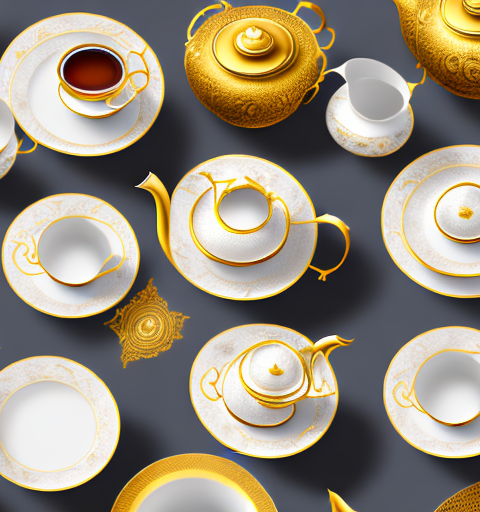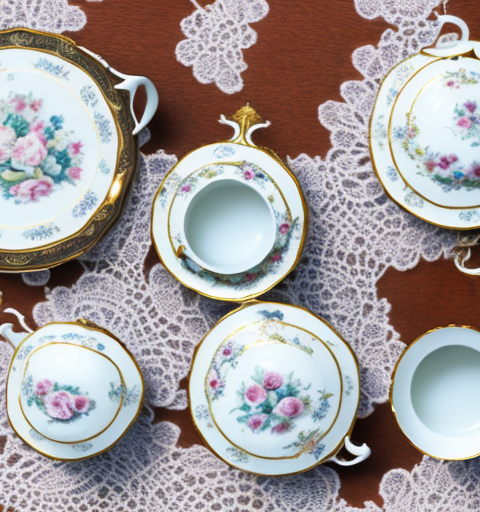Tea stains can be a common annoyance on ceramic teapots, especially those with embossed patterns. If you’re wondering how to effectively remove these stubborn stains and restore the pristine condition of your teapot, this article is for you. We’ll delve deep into the understanding of tea stain problems on ceramic teapots and explore various cleaning methods, including natural remedies and specialized cleaners. Additionally, we’ll provide you with helpful tips and tricks to prevent future tea stains on your beloved ceramic teapot.
Understanding the tea stain problem on ceramic teapots
Tea stains occur when the tannins, natural compounds found in tea, adhere to the surface of the ceramic material. Over time, these stains can become deeply embedded in the porous structure of the ceramic, making them more difficult to remove. Furthermore, teapots with embossed patterns can pose an additional challenge, as the intricate designs and crevices can accumulate and trap tea residues, leading to more noticeable stains.
One way to prevent tea stains on ceramic teapots is to properly clean and dry them after each use. This can help remove any residual tea and prevent the tannins from adhering to the surface. Additionally, using a soft brush or sponge and mild dish soap can help remove any stubborn stains that have already formed.
If tea stains have already become deeply embedded in the ceramic, there are several methods that can be used to remove them. One common method is to create a paste using baking soda and water, and gently scrub the stained areas with a soft cloth or sponge. Another option is to soak the teapot in a mixture of vinegar and water, which can help break down the stains. It is important to rinse the teapot thoroughly after using any cleaning method to remove any residue and prevent any unwanted flavors from lingering.
The importance of maintaining a clean teapot
A clean teapot not only enhances the visual appeal of your brewing experience but also ensures the optimal taste of your tea. Tea stains can alter the flavor of subsequent brews, leaving a residual bitter or off-taste. Moreover, neglected tea stains may harbor bacteria or mold, compromising the hygiene of your teapot. Therefore, regular cleaning and stain removal are crucial for both aesthetic and functional reasons.
In addition to affecting the taste and hygiene of your tea, a dirty teapot can also impact the overall lifespan of the teapot itself. Tea stains can build up over time and become more difficult to remove, potentially causing permanent discoloration or damage to the teapot’s surface. By regularly cleaning your teapot, you can prevent these stains from becoming deeply ingrained and extend the longevity of your teapot.
Furthermore, a clean teapot can contribute to the overall enjoyment of your tea-drinking experience. When you pour tea from a clean teapot, you can be confident that there are no residual flavors or odors from previous brews that may affect the taste of your current tea. This allows you to fully appreciate the nuanced flavors and aromas of each tea variety, ensuring a more satisfying and immersive tea-drinking experience.
Identifying tea stains on ceramic teapots with embossed patterns
Tea stains on ceramic teapots with embossed patterns can be visually distinct. The embossed designs tend to accumulate more tea residues, resulting in darker and more pronounced stains. Additionally, the crevices and grooves of the patterns may make it harder to remove the stains completely using traditional cleaning methods. Therefore, it is important to identify these unique characteristics when tackling the cleaning process.
One way to identify tea stains on ceramic teapots with embossed patterns is by examining the color and texture of the stains. Tea stains on embossed patterns often appear as dark, discolored areas that contrast with the surrounding ceramic surface. The stains may also have a rough or gritty texture due to the accumulation of tea residues in the crevices and grooves of the embossed design.
Another method of identifying tea stains on ceramic teapots with embossed patterns is by observing the pattern itself. The stains may follow the contours of the embossed design, highlighting the intricate details of the pattern. This can make the stains more noticeable and challenging to remove, as traditional cleaning methods may not effectively reach into the crevices and remove all traces of the tea residue.
Factors that contribute to tea stains on ceramic teapots
Several factors can contribute to the formation of tea stains on ceramic teapots. The type of tea used, brewing temperature, steeping time, and the frequency of use all play a role. Certain teas, such as black tea or herbal infusions, are more likely to leave stubborn stains due to their higher tannin content. Similarly, longer steeping times or repeated use without cleaning can lead to more noticeable tea stains. Understanding these factors can help tailor your cleaning approach accordingly.
In addition to the factors mentioned above, the quality of the water used for brewing tea can also contribute to tea stains on ceramic teapots. Hard water, which contains high levels of minerals like calcium and magnesium, can leave behind mineral deposits that can contribute to the formation of stains. Using filtered or distilled water can help reduce the likelihood of tea stains.
Furthermore, the material and finish of the ceramic teapot can also affect the formation of tea stains. Teapots with rough or porous surfaces are more prone to staining as the tea particles can easily get trapped in the tiny crevices. Smooth, glazed teapots are generally easier to clean and less likely to develop stubborn stains. It is important to choose a teapot with a suitable material and finish to minimize the occurrence of tea stains.
Preparing the teapot for cleaning: Step-by-step guide
Before diving into specific cleaning methods, it is important to properly prepare your teapot for the stain removal process. Start by emptying any remaining tea and rinsing the teapot with warm water to remove loose surface debris. Gently wipe the exterior and interior of the teapot with a soft cloth or sponge to remove any surface dirt or grime. Once the preliminary cleaning is done, your teapot is ready for the subsequent tea stain removal techniques.
After wiping the teapot, it is recommended to inspect the spout and handle for any stubborn stains or residue. Use a small brush or toothbrush to gently scrub these areas, being careful not to scratch the surface of the teapot. This will ensure that all parts of the teapot are thoroughly cleaned and ready for use.
In addition to cleaning the teapot itself, it is also important to clean the teapot’s lid and strainer, if applicable. Remove the lid and rinse it under warm water, using a soft cloth or sponge to remove any stains or residue. If your teapot has a built-in strainer, remove it and clean it separately, making sure to remove any trapped tea leaves or debris. Once the lid and strainer are clean, reassemble them with the teapot and proceed with the tea stain removal techniques.
Exploring different cleaning methods for removing tea stains from ceramic teapots
Cleaning tea stains from ceramic teapots can be approached in various ways, depending on the severity of the stains and the materials at hand. In the following sections, we will discuss natural remedies and specialized cleaners that are commonly used to combat tea stains. You can choose the method that suits your preference and the materials available to you.
One natural remedy for removing tea stains from ceramic teapots is using a mixture of baking soda and vinegar. This combination creates a powerful cleaning agent that can effectively break down and remove stubborn stains. Simply sprinkle baking soda inside the teapot, then pour vinegar over it. Allow the mixture to sit for a few minutes before scrubbing the stains with a soft brush or sponge. Rinse thoroughly with water afterwards.
If you prefer using specialized cleaners, there are several options available in the market specifically designed for removing tea stains from ceramic surfaces. These cleaners often contain ingredients such as citric acid or oxalic acid, which are known for their stain-removing properties. Follow the instructions provided on the cleaner’s packaging for best results. Remember to rinse the teapot thoroughly after using any cleaning product to ensure no residue is left behind.
Using natural remedies to remove tea stains from a teapot with an embossed pattern
Natural remedies provide an effective and eco-friendly approach to removing tea stains from ceramic teapots. One of the most versatile solutions is baking soda. Its mildly abrasive nature helps to gently scrub away stains without damaging the ceramic surface. To use baking soda, create a paste by mixing it with a small amount of water. Apply the paste to the stained areas, let it sit for a few minutes, and then scrub gently with a soft brush or sponge. Rinse thoroughly with warm water to remove any residue.
Another natural remedy is vinegar. The acidic properties of vinegar make it effective in breaking down tea stains. Mix equal parts of white vinegar and water, and soak a clean cloth or sponge in the solution. Wring out the excess liquid and gently rub the stained areas. Allow the vinegar solution to sit for a few minutes before rinsing with warm water. Remember to thoroughly rinse the teapot to remove the vinegar smell.
Lemon juice is another excellent natural option. The citric acid in lemon juice acts as a mild bleach, helping to lighten and dissolve tea stains. Squeeze fresh lemon juice onto a damp cloth or sponge and gently rub the stains. If the stains are particularly stubborn, you can let the lemon juice sit on the surface for a few minutes before rinsing with warm water.
The power of baking soda: A versatile solution for cleaning tea stains on ceramic teapots
Baking soda is a highly versatile and effective solution for cleaning tea stains on ceramic teapots. Apart from the natural remedy mentioned earlier, baking soda can also be combined with other ingredients for enhanced stain removal. One popular method involves creating a paste by mixing equal parts baking soda and water. Apply the paste to the stained areas and let it sit for at least 30 minutes or overnight for deeper stains. Then, scrub gently with a soft brush or sponge and rinse thoroughly with warm water. Baking soda can be safely used on embossed patterns, but it is advisable to avoid excessive scrubbing to prevent potential damage to delicate details.
Vinegar magic: How to effectively remove tea stains from a ceramic teapot
Vinegar is a powerful cleaning agent that can effectively remove tea stains from ceramic teapots. In addition to the natural remedy method discussed earlier, vinegar can be used in a slightly different way. Fill the teapot with equal parts water and white vinegar, and let it soak for at least 1-2 hours or overnight, depending on the severity of the stains. After soaking, scrub the stains gently with a soft brush or sponge, paying attention to the embossed areas. Rinse the teapot thoroughly with warm water to remove any residual vinegar smell. This method is particularly useful for stubborn or deeply ingrained tea stains.
Lemon juice and its role in removing tea stains from ceramics with embossed patterns
Lemon juice, with its natural acidity, can be remarkably effective in removing tea stains from ceramic teapots with embossed patterns. A simple method involves cutting a lemon in half and rubbing the stained areas with the cut side. For more convenience, you can squeeze fresh lemon juice onto a clean cloth or sponge, then gently scrub the stains. Allow the lemon juice to sit for a few minutes before rinsing with warm water. Lemon juice not only helps to dissolve tea stains, but it also leaves a refreshing aroma.
Brushing away the stains: Effective scrubbing techniques for ceramic teapots
When it comes to scrubbing tea stains on ceramic teapots, it is important to strike a balance between being thorough and gentle. Choose a soft-bristled brush or sponge to avoid scratching or damaging the ceramic surface. Using a circular or back-and-forth motion, gently scrub the stained areas, paying extra attention to the embossed patterns. It is advisable to start with a gentle approach and gradually increase the pressure if needed. Regularly rinse the teapot during scrubbing to remove any loosened tea residues. After scrubbing, rinse the teapot thoroughly with warm water to remove any remaining debris.
Soaking and softening tea stains for easy removal on embossed ceramic teapots
Soaking the tea-stained ceramic teapot can be an effective method to soften the stains, making them easier to remove. Fill the teapot with warm water and add a small amount of dish soap or mild detergent. Let the teapot soak for at least 1-2 hours, or overnight for more stubborn stains. The warm water and detergent combination will help loosen the tea stains from both the smooth surface and the tiny crevices of embossed patterns. After soaking, gently scrub the stains with a soft brush or sponge, and rinse the teapot thoroughly with warm water. This method is particularly suitable for delicate embossed patterns that may require a gentler cleaning approach.
The role of specialized cleaners in removing stubborn tea stains from ceramic teapots
In some cases, tea stains on ceramic teapots may be particularly stubborn or deeply ingrained, requiring the use of specialized cleaners. There are various ceramic or multi-purpose cleaners available on the market that are specifically formulated to remove tough stains. It is important to carefully read and follow the instructions provided by the manufacturer. These cleaners often involve a combination of gentle abrasives and chemical agents to break down and remove tea stains. Remember to rinse the teapot thoroughly after using specialized cleaners to remove any remaining residue or cleaning agents.
Tips and tricks for preventing future tea stains on your beloved ceramic teapot
Prevention is always better than cure when it comes to tea stains on ceramic teapots. By implementing a few easy practices, you can minimize the occurrence of tea stains and keep your teapot looking its best:
– Rinse your teapot immediately after use: A quick rinse with warm water can help remove tea residues before they have a chance to settle and stain the ceramic surface.
– Regularly clean your teapot: Establish a routine of cleaning your teapot thoroughly after each use. This will prevent tea stains from building up and becoming more difficult to remove over time.
– Avoid leaving tea in the teapot for extended periods: If you’re not going to use the teapot for an extended period, empty and clean it promptly instead of leaving tea to sit and potentially stain the ceramic.
– Use a teapot cozy: A teapot cozy can help maintain the temperature of your tea and prevent excess condensation, which can contribute to tea stains. Additionally, it adds an extra layer of protection to your teapot.
– Consider using a tea filter or infuser: Using a tea filter or infuser can help contain loose tea leaves and minimize direct contact with the teapot, reducing the chances of tea stains.
Conclusion
Tea stains on ceramic teapots with embossed patterns can be unsightly and persistent. However, with the right knowledge and proper cleaning techniques, removing these stains is achievable. From natural remedies such as baking soda, vinegar, and lemon juice to specialized cleaners, there are various methods to choose from. By following the step-by-step guide and implementing preventative measures, you can restore the cleanliness and beauty of your beloved ceramic teapot and ensure a delightful tea brewing experience every time.






